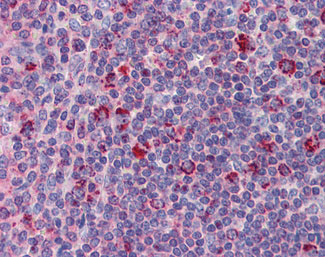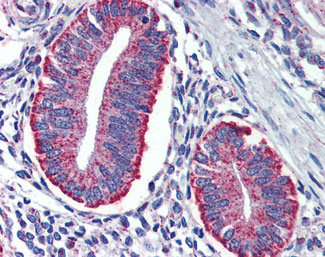DAP12 Antibody
Goat Polyclonal Antibody
- SPECIFICATION
- CITATIONS
- PROTOCOLS
- BACKGROUND

Application
| IHC-P, E |
|---|---|
| Primary Accession | O43914 |
| Reactivity | Human, Monkey, Horse, Dog |
| Host | Goat |
| Clonality | Polyclonal |
| Calculated MW | 12kDa |
| Dilution | IHC-P (3-6 µg/ml) |
| Gene ID | 7305 |
|---|---|
| Other Names | TYRO protein tyrosine kinase-binding protein, DNAX-activation protein 12, Killer-activating receptor-associated protein, KAR-associated protein, TYROBP, DAP12, KARAP |
| Target/Specificity | Human TYROBP / DAP12. This antibody is expected to recognize both reported isoforms (NP_003323.1; NP_937758.1) |
| Reconstitution & Storage | Store at -20°C. Minimize freezing and thawing. |
| Precautions | DAP12 Antibody is for research use only and not for use in diagnostic or therapeutic procedures. |
| Name | TYROBP (HGNC:12449) |
|---|---|
| Function | Adapter protein which non-covalently associates with activating receptors found on the surface of a variety of immune cells to mediate signaling and cell activation following ligand binding by the receptors (PubMed:10604985, PubMed:9490415, PubMed:9655483). TYROBP is tyrosine-phosphorylated in the ITAM domain following ligand binding by the associated receptors which leads to activation of additional tyrosine kinases and subsequent cell activation (PubMed:9490415). Also has an inhibitory role in some cells (PubMed:21727189). Non-covalently associates with activating receptors of the CD300 family to mediate cell activation (PubMed:15557162, PubMed:16920917, PubMed:17928527, PubMed:26221034). Also mediates cell activation through association with activating receptors of the CD200R family (By similarity). Required for neutrophil activation mediated by integrin (By similarity). Required for the activation of myeloid cells mediated by the CLEC5A/MDL1 receptor (PubMed:10449773). Associates with natural killer (NK) cell receptors such as KIR2DS2 and the KLRD1/KLRC2 heterodimer to mediate NK cell activation (PubMed:23715743, PubMed:9490415, PubMed:9655483). Also enhances trafficking and cell surface expression of NK cell receptors KIR2DS1, KIR2DS2 and KIR2DS4 and ensures their stability at the cell surface (PubMed:23715743). Associates with SIRPB1 to mediate activation of myeloid cells such as monocytes and dendritic cells (PubMed:10604985). Associates with TREM1 to mediate activation of neutrophils and monocytes (PubMed:10799849). Associates with TREM2 on monocyte-derived dendritic cells to mediate up-regulation of chemokine receptor CCR7 and dendritic cell maturation and survival (PubMed:11602640). Association with TREM2 mediates cytokine-induced formation of multinucleated giant cells which are formed by the fusion of macrophages (PubMed:18957693). Stabilizes the TREM2 C-terminal fragment (TREM2-CTF) produced by TREM2 ectodomain shedding which suppresses the release of pro-inflammatory cytokines (PubMed:25957402). In microglia, required with TREM2 for phagocytosis of apoptotic neurons (By similarity). Required with ITGAM/CD11B in microglia to control production of microglial superoxide ions which promote the neuronal apoptosis that occurs during brain development (By similarity). Promotes pro-inflammatory responses in microglia following nerve injury which accelerates degeneration of injured neurons (By similarity). Positively regulates the expression of the IRAK3/IRAK-M kinase and IL10 production by liver dendritic cells and inhibits their T cell allostimulatory ability (By similarity). Negatively regulates B cell proliferation (PubMed:21727189). Required for CSF1-mediated osteoclast cytoskeletal organization (By similarity). Positively regulates multinucleation during osteoclast development (By similarity). |
| Cellular Location | Cell membrane; Single-pass type I membrane protein |
| Tissue Location | Expressed at low levels in the early development of the hematopoietic system and in the promonocytic stage and at high levels in mature monocytes. Expressed in hematological cells and tissues such as peripheral blood leukocytes and spleen. Also found in bone marrow, lymph nodes, placenta, lung and liver. Expressed at lower levels in different parts of the brain especially in the basal ganglia and corpus callosum. |

Thousands of laboratories across the world have published research that depended on the performance of antibodies from Abcepta to advance their research. Check out links to articles that cite our products in major peer-reviewed journals, organized by research category.
info@abcepta.com, and receive a free "I Love Antibodies" mug.
Provided below are standard protocols that you may find useful for product applications.
Background
Non-covalently associates with activating receptors of the CD300 family. Cross-linking of CD300-TYROBP complexes results in cellular activation. Involved for instance in neutrophil activation mediated by integrin.
References
Lanier L.L.,et al.Nature 391:703-707(1998).
Cantoni C.,et al.Submitted (AUG-1998) to the EMBL/GenBank/DDBJ databases.
Begum N.A.,et al.Submitted (JAN-2002) to the EMBL/GenBank/DDBJ databases.
Kalnine N.,et al.Submitted (AUG-2003) to the EMBL/GenBank/DDBJ databases.
Ota T.,et al.Nat. Genet. 36:40-45(2004).
If you have used an Abcepta product and would like to share how it has performed, please click on the "Submit Review" button and provide the requested information. Our staff will examine and post your review and contact you if needed.
If you have any additional inquiries please email technical services at tech@abcepta.com.













 Foundational characteristics of cancer include proliferation, angiogenesis, migration, evasion of apoptosis, and cellular immortality. Find key markers for these cellular processes and antibodies to detect them.
Foundational characteristics of cancer include proliferation, angiogenesis, migration, evasion of apoptosis, and cellular immortality. Find key markers for these cellular processes and antibodies to detect them. The SUMOplot™ Analysis Program predicts and scores sumoylation sites in your protein. SUMOylation is a post-translational modification involved in various cellular processes, such as nuclear-cytosolic transport, transcriptional regulation, apoptosis, protein stability, response to stress, and progression through the cell cycle.
The SUMOplot™ Analysis Program predicts and scores sumoylation sites in your protein. SUMOylation is a post-translational modification involved in various cellular processes, such as nuclear-cytosolic transport, transcriptional regulation, apoptosis, protein stability, response to stress, and progression through the cell cycle. The Autophagy Receptor Motif Plotter predicts and scores autophagy receptor binding sites in your protein. Identifying proteins connected to this pathway is critical to understanding the role of autophagy in physiological as well as pathological processes such as development, differentiation, neurodegenerative diseases, stress, infection, and cancer.
The Autophagy Receptor Motif Plotter predicts and scores autophagy receptor binding sites in your protein. Identifying proteins connected to this pathway is critical to understanding the role of autophagy in physiological as well as pathological processes such as development, differentiation, neurodegenerative diseases, stress, infection, and cancer.



